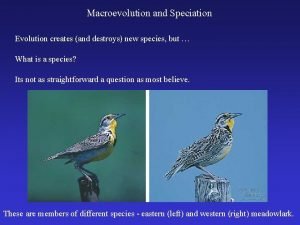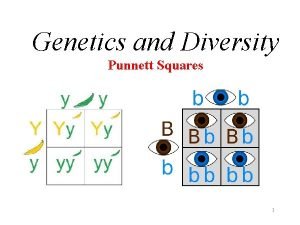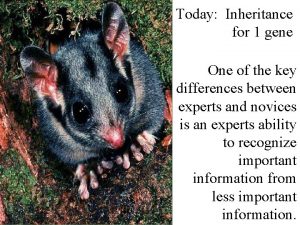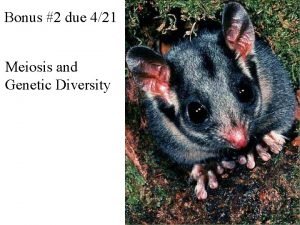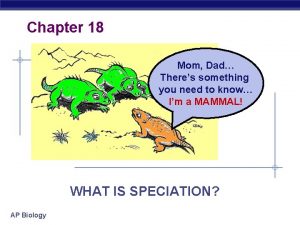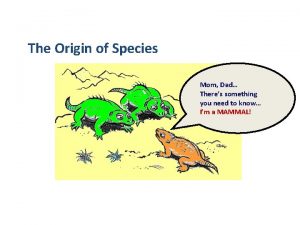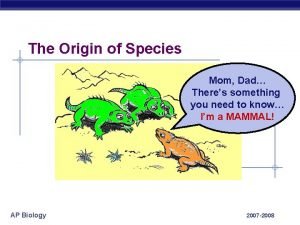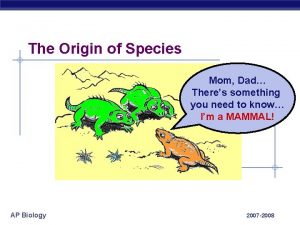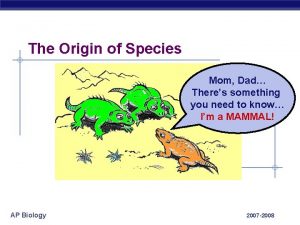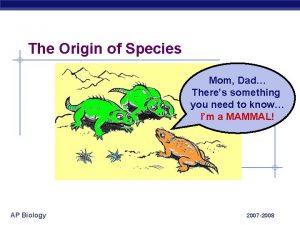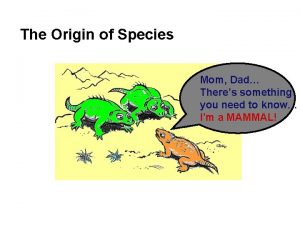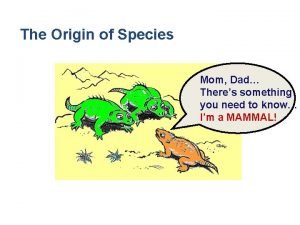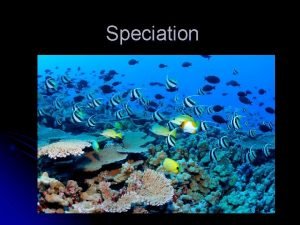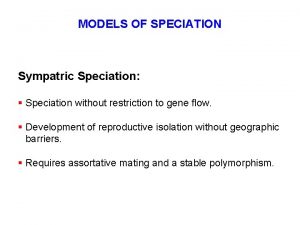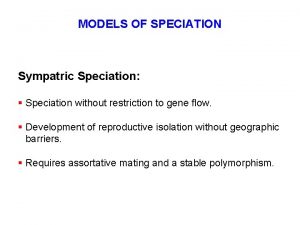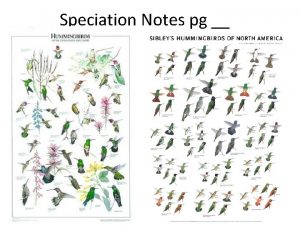Speciation Mom Dad Theres something you need to




























- Slides: 28

Speciation Mom, Dad… There’s something you need to know… I’m a MAMMAL! AP Biology

“That mystery of mysteries…” Darwin never actually tackled how new species arose… Both in space and time, we seem to be brought somewhat near to that great fact —that mystery of mysteries— the first appearance of new beings on this Earth. AP Biology Minzenmayer

What is a species? § Biological species concept Defined by Ernst Mayr Populations that actually or potentially interbreed in nature and produce viable, fertile offspring Reproductively compatible AP Biology All belong to species Theridion grallator —can interbreed Even though they look different

Biological Species Concept AP Biology

Problems with Biological Species Concept § Asexually reproducing organisms? § Organisms that sometimes form hybrids? § What is potentially interbreeding? § Ring species AP Biology

How and why do new species originate? § Species are created by a series of evolutionary processes populations become isolated geographically isolated reproductively isolated populations evolve independently § Isolation allopatric geographic separation sympatric AP Biology still live in same area Minzenmayer

Defining Speciation § Lineage splitting event that produces two or more separate species § Branching points are speciation events AP Biology

PRE-reproduction barriers § Obstacle to mating or to fertilization if mating occurs geographic isolation AP Biology behavioral isolation ecological isolation mechanical isolation temporal isolation Minzenmayer 2005 -2006 gametic isolation

Geographic Isolation § Species occur in different areas physical barrier allopatric speciation “other country” AP Biology Minzenmayer 2005 -2006

Speciation Example Population of wild fruit flies Cheerfully laying eggs on Rotting bananas Disaster strikes Hurricane washes bananas and immature fruit flies out to sea. Banana bunch washes up on island off coast of mainland AP Biology

Speciation Example Populations diverge So we meet again… AP Biology

Ecological/Habitat Isolation § Species occur in same region, but occupy different habitats so rarely encounter each other reproductively isolated 2 species of garter snake, Thamnophis, occur in same area, but one lives in water & other is terrestrial AP Biology lions & tigers could hybridize, but they live in different habitats: § lions in grasslands § tigers in rainforest Minzenmayer 2005 -2006

Temporal isolation § Species that breed during different times of day, different seasons, or different years cannot mix gametes reproductive isolation sympatric speciation “same country” Eastern spotted skunk (L) & western spotted skunk (R) overlap in range but eastern mates in late winter & western mates AP Biology in late summer Minzenmayer

Sympatric speciation § New species formed within the range of the ancestral population § Does not require large scale geographic distance to reduce gene flow § Species might exploit a new niche Automatically reduces gene flow with those individuals exploiting different niche § Polyploids AP Biology

Sympatric Speciation Apple maggot flies apples hawthorns Gene flow reduced between flies that feed on different food varieties, even though they both live in the same area AP Biology

sympatric speciation? Behavioral isolation § Unique behavioral patterns & rituals isolate species identifies members of species attract mates of same species courtship rituals, mating calls reproductive isolation AP Biology Blue footed boobies mate only after a courtship display unique to their species Minzenmayer 2005 -2006

sympatric speciation? Mechanical isolation § Morphological differences can prevent successful mating reproductive isolation Plants Even in closely related species of plants, the flowers often have distinct appearances that attract different pollinators. These 2 species of monkey flower differ greatly in shape & color, therefore cross-pollination does not happen. AP Biology Minzenmayer

Mechanical isolation Animals § For many insects, male & female sex organs of closely related species do not fit together, preventing sperm transfer lack of “fit” between sexual organs: hard to imagine for us… but a big issue for insects with different shaped genitals! Damsel fly penises AP Biology Minzenmayer

sympatric speciation? Gametic isolation § Sperm of one species may not be able to fertilize eggs of another species mechanisms biochemical barrier so sperm cannot penetrate egg receptor recognition: lock & key between egg & sperm chemical incompatibility sperm cannot survive in female reproductive tract Sea urchins release sperm & eggs into surrounding waters where they fuse & form zygotes. Gametes of different species— red & purple —are unable to fuse. AP Biology Minzenmayer 2005 -2006

POST-reproduction barriers § Prevent hybrid offspring from developing into a viable, fertile adult reduced hybrid viability reduced hybrid fertility hybrid breakdown AP Biology zebroid Minzenmayer 2005 -2006

sympatric speciation? Reduced hybrid viability § Genes of different parent species may interact & impair the hybrid’s development Species of salamander genus, Ensatina, may interbreed, but most hybrids do not complete development & those that do are frail. AP Biology Minzenmayer 2005 -2006

Reduced hybrid fertility § Even if hybrids are vigorous they may be sterile chromosomes of parents may differ in number or structure & meiosis in hybrids may fail to produce normal gametes Mules are vigorous, but sterile Horses have 64 chromosomes (32 pairs) AP Biology Mules have 63 chromosomes! Donkeys have 62 chromosomes (31 pairs) Minzenmayer 2005 -2006

sympatric speciation? Hybrid breakdown § Hybrids may be fertile & viable in first generation, but when they mate offspring are feeble or sterile In strains of cultivated rice, hybrids are vigorous but plants in next generation are small & sterile. On path to separate species. AP Biology Minzenmayer 2005 -2006

Rate of Speciation § Current debate: Does speciation happen gradually or rapidly Gradualism Charles Darwin Charles Lyell Punctuated equilibrium Stephen Jay Gould Niles Eldredge AP Biology Niles Eldredge Curator American Museum of. Minzenmayer Natural 2005 -2006 History

Gradualism § Gradual divergence over long spans of time assume that big changes occur as the accumulation of many small ones AP Biology Minzenmayer 2005 -2006

Punctuated Equilibrium § Rate of speciation is not constant Species undergo most change when they first bud from parent population As separate species, remain static for long periods of time AP Biology Minzenmayer 2005 -2006

Stephen Jay Gould (1941 -2002) § Harvard paleontologist & evolutionary biologist punctuated equilibrium prolific author popularized evolutionary thought AP Biology Minzenmayer 2005 -2006

AP Biology Minzenmayer 2005 -2006
 Where theres smoke theres fire meaning
Where theres smoke theres fire meaning Where theres a will theres an a
Where theres a will theres an a Philip larkin they f you up
Philip larkin they f you up Sympatric speciation vs allopatric speciation
Sympatric speciation vs allopatric speciation Smart is not something you are
Smart is not something you are Theres something about marg
Theres something about marg Rich dad poor dad expense sheet
Rich dad poor dad expense sheet You are good when there's nothing good in me
You are good when there's nothing good in me Punnett square for brown and green eyes
Punnett square for brown and green eyes Punnett square question
Punnett square question Blue eyed father brown eyed mother
Blue eyed father brown eyed mother What is the theme of the poem dreaming black boy
What is the theme of the poem dreaming black boy Long division line
Long division line Picture of mom and dad
Picture of mom and dad Blood types chart
Blood types chart Concrete objects that represent abstract ideas
Concrete objects that represent abstract ideas Tells how something works or why something happens
Tells how something works or why something happens Open oven
Open oven What does concrete symbolize
What does concrete symbolize When something represents something else
When something represents something else Something old something new poem
Something old something new poem Is adjective a language feature
Is adjective a language feature Fact and opinion newspaper articles
Fact and opinion newspaper articles Don't take things that don't belong to you
Don't take things that don't belong to you If you deserve something you are
If you deserve something you are Emily dickinson 258
Emily dickinson 258 Gerald florian
Gerald florian No pencil poem
No pencil poem Nothing worth more
Nothing worth more



